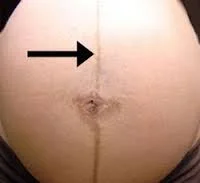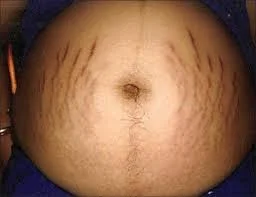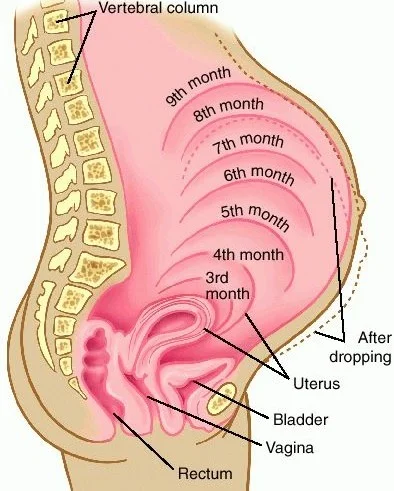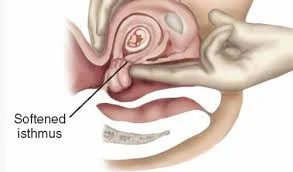Pregnancy
Medicolegal view
Definitions
Pregnancy is a physiological state in female where she conceives and carries developing product of conception in her uterus womb until birth of a child.
Medicolegal Importance-civil
- Nullity of marriage (no valid marriage) : If a female is pregnant before marriage from another person and she concealed the fact.
- Divorce.
- In case of breach (break) of promise of marriage.
- In alimony (support).
- Inheritance of Property.
- Blackmailing.
- Defamation.
- Compensation cases.
- Pregnancy may be taken as a plea (defense) to avoid court.
Medicolegal Importance-criminal
- proof of sexual intercourse in rape cases.
- cause for suicide in unmarried female.
- Pregnancy may be motive of murder.
- Execution of death sentence.
- concealment of birth.
DIAGNOSIS OF PREGNANCY IN LIVING
Presumptive evidence of pregnancy
-
SECONDARY AMENORRHEA.
-
BREAST CHANGES:
- Breast becomes full, tender and increases in size.
- Superficial veins become prominent.
- 8th week, hyperpigmentation of the areola and nipple occurs with appearance of Montgomery’s tubercles.
- 12th week, colostrum can be squeezed out of nipple and later milk can be extracted as pregnancy advances.
- However, these breast changes can also be seen in other conditions such as:
- Ovarian tumors secreting prolactin.
- Women taking contraceptive pills or tranquillizers.
-
Changes in Vagina:
- Jackquemir’s sign (or Chadwick’s sign): The normal pinkish mucosa of vagina changes to bluish by 4th week of pregnancy.
- Barne’s sign: Flattening of anterior vaginal wall due to upward tilting of cervix.
- Osiander’s sign: Palpable pulsation of the vaginal arteries felt through the lateral fornics at 8th week due to high arterial tension of pelvic arteries.
- The secretion of mucous from vagina is increased.
-
PIGMENTATION OF SKIN:
- Pigmentation may occur on forehead and cheeks in form of dark brown patches.
- A linear pigmentation known as linea nigra.
- The skin over abdomen shows depressed lines, pinkish or slightly bluish in appearance. These lines are called as striae gravidarum.
-
MORNING SICKNESS:
- Morning sickness refers to nausea and at times followed by vomiting soon after waking.
-
SYMPATHETIC DISTURBANCES:
- Increased salivation.
- Perverted appetite with desire for unusual food.
- Irritable temperament.
- Easy fatigability.
-
FREQUENCY OF MICTURITION:
- In early and late trimester of pregnancy, due to pressure of enlarging gravid uterus over bladder, the bladder gets irritated and due to which female have increase frequency of micturition.


Probable Evidence of Pregnancy
- Enlargement of abdomen:
- 12th week, uterus can be palpated just above symphysis pubis.
- 16th week it is half way between the symphysis and umbilicus.
- 20 weeks 2 fingers below the level of umbilicus.
- 22 weeks At the level of umbilicus.
- 24 weeks 2 fingers Above the level of umbilicus.
- 28 week the fundus raises one third of the way between umbilicus and xiphisternum.
- 32 week upper one third between umbilicus and xiphisternum.
- 38week the uterus reaches at the xiphisternum.

![]() Palmer’s sign- regular rhythmic contractions of uterus at 4th to 8th week.
Palmer’s sign- regular rhythmic contractions of uterus at 4th to 8th week.
-
Changes in cervix:
- Goodell’s sign: The cervix normally is hard as tip of nose. However, due to pregnancy, it begins to soften from below upwards and is felt soft as lips by 16th week.
- Mucous becomes thick and viscid plug blocks the cervical canal.
-
Hegar’s sign:
- Lower segment of uterus becomes soft and is easily compressible. It becomes positive at 8 to 10 weeks.
-
Ballottement:
- A technique of palpating an organ or floating structure by bouncing it gently and feeling it rebound.
- The test is positive by 16 to 20 weeks.
- Ballottement test can be negative if the amount of amniotic fluid is scanty.

- The laboratory tests for pregnancy:
-
Bio-assay or biological tests.
-
Immunoassay or immunological tests.
-
ELISA test.
-
Radio-immunoassay.

-
Immunological Tests:
- Immunological tests are based on principle that antigen present in urine or serum (hCG) reacts with antibody.
-
- Direct agglutination test:
- In this type of test, latex particles coated with anti-hCG monoclonal antibodies are mixed with urine. An agglutination reaction develops indicating a positive result. It means female is pregnant.
Fallacies of Tests Tests are based on Presence of hCG (as antigen). Could be positive in other conditions
1. Hydatidiform mole
2. Chorinoepithelioma

Positive Evidence of Pregnancy
- Fetal parts and fetal movements: The test can be done by palpation of fetal parts and movements by placing hands over abdomen. Fetal movements are appreciated by 16 to 20 weeks.
- Fetal heart sounds (soufflé): Is absolute sign of pregnancy and usually heard at about 18 to 20 week.
- X-ray examination: By X-ray, the diagnosis of pregnancy can be certain after 16th week. X-ray will reveal fetal skeleton in form of Circular shadow of skull outline.
- Sonography: By this method, gestational sac (ring) is determined by 5th week and distinct echo’s of embryo within gestational sac by 8th week.
Diagnosis of Pregnancy in Dead
In addition to signs found in living persons, following are important signs of pregnancy found in dead female:
-
Presence of product of conception.
-
Presence of placenta.
-
Changes in uterus:
- Uterus is enlarged, thickened and increase in size.
- Marks of attachment of placenta.
- Microscopic examination of uterus reveals hypertrophy and hyperplasia of myometrium.
-
Changes in ovary:
- Corpus luteum is present and attains largest size at about 16th week of pregnancy. It secretes progesterone.
-
Laboratory investigation:
- hCG can be detected in blood/urine.
Average duration of pregnancy
- Ovulatory (fertilisation) age: ≈ 266 days (38 lunar weeks) counted from conception.
- Gestational (menstrual) age: ≈ 280 days (40 lunar weeks ≈ 9 calendar months + 7 days) counted from the first day of the last menstrual period (LMP) in women with regular cycles.
The ovulatory age is mainly used by histologists/embryologists, whereas obstetricians and legal professionals refer to the gestational age.
Viability limits
- Minimum: a child born ≥ 210 days (≈ 7 months) is generally viable, though rare survivals have occurred earlier.
- Maximum: births have been reported up to 352 days after the LMP.
Calculating the Expected Date of Delivery (EDD)
- Naegele’s rule – add 7 days to the LMP, then count back three months (≈ 90 days). In a leap year, add 6 days instead of 7.
- Sonographic method – estimate EDD by measuring fetal parameters such as crown‑rump length or biparietal diameter.
Estimating the duration of pregnancy
- Clinical method – assess the height of the uterine fundus relative to anatomical landmarks (e.g., when the fundus reaches the umbilicus, the pregnancy is roughly 24 weeks).
Pseudocyesis (false pregnancy)
- Synonyms: false or spurious pregnancy, phantom pregnancy, imaginary pregnancy.
- The woman believes she is pregnant despite the absence of a fetus.
- She experiences subjective pregnancy symptoms (enlarged abdomen, breast changes, amenorrhoea) and may imagine fetal growth.
- Imaging (X‑ray or sonography) quickly resolves the condition.